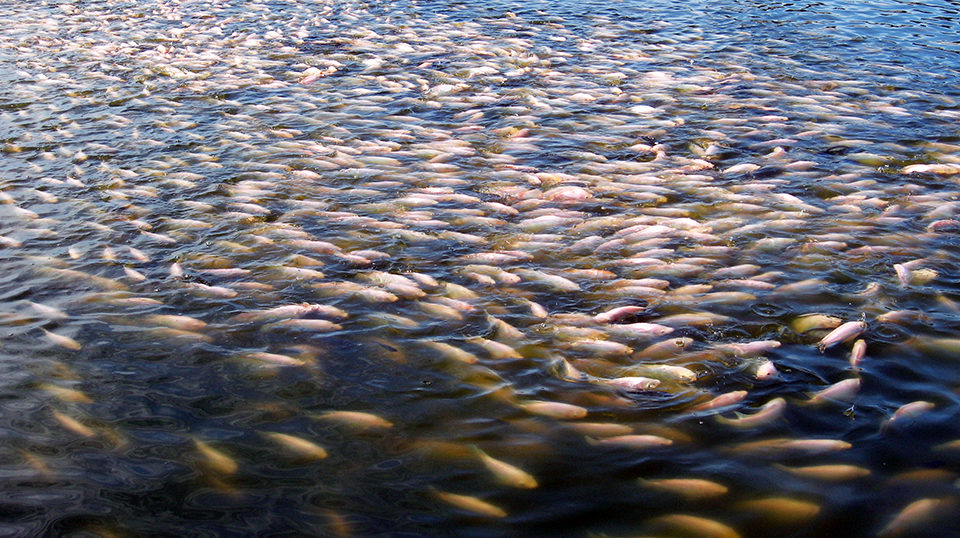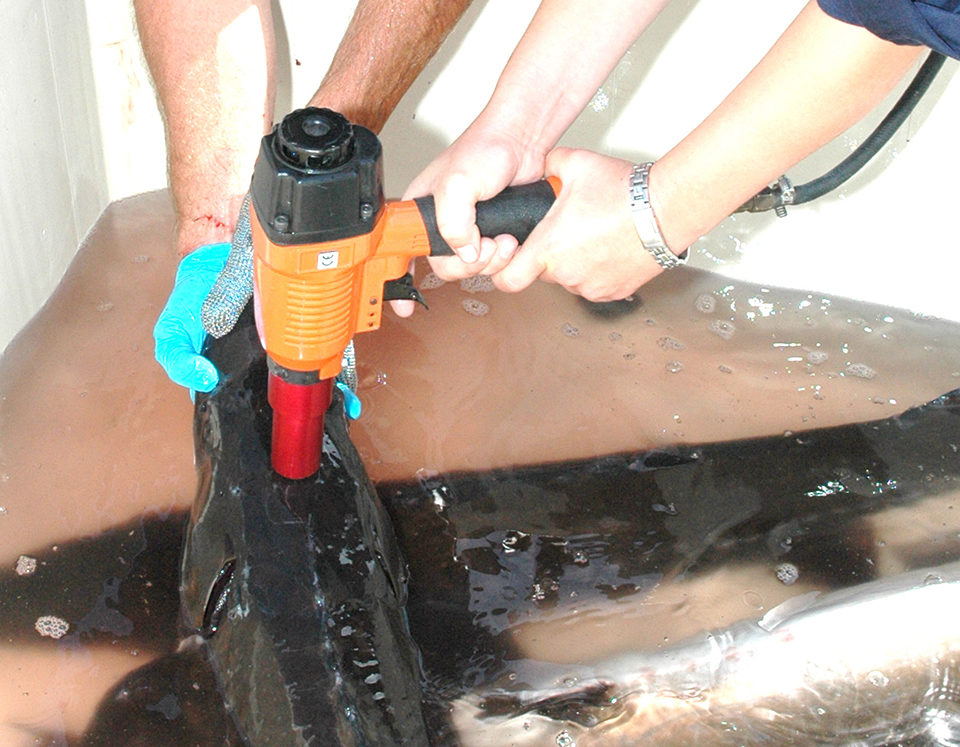Ability to perceive pain requires a higher level of sophistication in neural, physiological development

Aquatic animal welfare and humane slaughter in production aquaculture are concepts that elicit strong emotions internationally. For the most part, international attitudes for these concepts range from acceptance, through avoidance of the question, to outright rejection. What influences these positions includes the particular culture addressing the issues; attitudes toward food animals that we rear, slaughter and consume; and most assuredly, economics and markets. In addition, significant resistance to welfare concepts often results in failure to differentiate between animal rights and animal welfare.
Supporters of animal rights maintain a philosophy that animals have the same rights as people. Advocates for animal welfare have been defined as possessing concern for the well-being of individual animals, unrelated to the perceived rights of the animal or the ecological dynamics of the species. In general, those who support animal welfare usually focus on the morality of human action (or inaction), as opposed to making deeper political or philosophical claims about the status of animals in our care.
Primarily Western issue
Currently, animal welfare and humane slaughter of food animals are primarily a western phenomenon. The European Union and the United Kingdom and its commonwealth countries have adopted production and slaughter standards for aquatic animal welfare in both mainstream and organic production. They are leading efforts in the study of the neural, physiological and animal behavior associated with the welfare of aquatic animal species. Canada is the only North American country pursuing aquatic animal welfare efforts to this extent. With few exceptions, Asia, Africa and Latin America are not widely known for efforts in the animal welfare arena.
The United States is among the largest importers of aquaculture products internationally and has a significant aquaculture industry. However, the U.S. industry, as a whole, has exhibited a mixed response to embracing aquatic animal welfare in its farm management protocols, and few U.S. scientists are addressing research on the neural, physiological and behavioral aspects of finfish relative to animal welfare.
Which species?
A major question being addressed by both the international industry and science is which aquatic animals warrant welfare status? Human emotions may suggest that all animals do, but most scientists, including ethnologists, reserve welfare status for those animals that have the capacity to experience pain and suffering.
The ability to perceive pain requires a higher level of sophistication in neural and physiological development. The standards for determining the essential components for the perception of pain, including possession of consciousness, awareness and an interpretative center for pain, were established using the human model and the ability to communicate with the patient.
What about an oyster? Does it have the potential for pain and suffering? The neural anatomy and physiological systems of a molluscan shellfish possess a more simplistic design than that of humans or even fish.
Most oysters, clams and mussels have a basic neural system consisting of interconnected nerve tracts and a series of nerve bundles called ganglia. They are believed not to have the capacity for pain and suffering. However, because of the higher level of neural development and behavioral aspects of many finfish species, cultured finfish have been a major focus in the international debate surrounding animal welfare.
Rose’s research
In 2002, William Rose published a paper in Reviews in Fisheries Science in which he proposed that fishes’ behavioral responses to noxious stimuli are separate from the psychological experience of pain. He expressed that since awareness of pain in humans depends on functions of specific regions of the cerebral cortex, and since fish lack these essential brain regions or any functional equivalent, this makes it untenable that fish can experience pain. This would mean that a fish’s reaction to a nocuous stimulus is a reflex action activated at the level of the receptor and spinal cord, and does not include the brain.
Rose’s paper focused the attention of a large segment of the scientific community, which in turn launched hundreds of studies devoted to the issue of pain in fish. Research on fish includes neural anatomy, neurophysiology, animal behavior and pharmacological studies.
Some of these studies have reported that the neural systems and pathways necessary for the transmission of a nocuous stimulus to the brain do exist in fish and demonstrated pain-mitigating substances that are triggered and released following a nocuous stimulus applied to the fish. These substances, called ophoids, have an analgesic effect in lessening pain in humans and are also found in fish.
Contemporary studies are now investigating genes common to both fish and humans that in humans are associated with pain interpretative activities and the neocortex. In fish, these activities are being studied in the midbrain and forebrain, where electrical impulses have been identified following application of a nocuous stimulus in rainbow trout, goldfish and Atlantic salmon. These areas are the potential analogous interpretative centers in the brain of fish that may function in a way similar to the neocortex in humans.
Researching concepts of pain in production animals is both difficult and complicated. The major challenge is to determine if analogous pain interpretive centers are present in production animals, none of which can communicate their experiences.
Scientific community divided
Where are we today in this finfish debate? Internationally, the scientific community is still divided.
The American Fisheries Society, in its Guidelines for the Use of Fishes in Research, emphasizes stress reduction in handling of fish, but recommends Rose’s position concerning pain in fish. Equivalent institutions in Canada, the European Union and United Kingdom do not support Rose’s position.
Most significant in this debate are the positions taken in a 2009 issue of the Institute for Laboratory Animal Research’s ILAR Journal, addressing pain and distress in fish. ILAR Journal is a publication of the U.S. National Academies and the National Research Council.
The positions expressed in the journal support the concept that although the definitive research proving that fish feel pain and distress has yet to be concluded, enough evidence has been produced that supports the premise that fish should be given the benefit of the doubt and provided a welfare status. This is the position supported by the government and industries in the European Union and the United Kingdom. How this will play out in the U.S. has yet to be determined.
Proactive companies
Some U.S. companies and international companies with facilities in the United States. are taking proactive steps to remain ahead of the curve on animal welfare issues. Sterling Caviar in California has established animal welfare protocols, including methods of humane slaughter, to meet these international standards because of the international marketing of their caviar products.
Humane slaughter protocols as defined in the U.K. and E.U. do not subject animals to undo stress prior to slaughter from excessive crowding, excessive chilling, low oxygen or anoxia, or rough handling. There are also protocols in which the animals are rendered instantaneously insensible prior to slaughter by percussion stunning, electrical stunning or electrocution.
At Sterling Caviar, sturgeons are rendered unconscious with a blow to the head prior to bleeding and slaughter. Studies conducted by the University of California Davis in cooperation with Sterling demonstrated the effective use of captive bolt guns to stun fish larger than 40 kg.
Saggital sections of a sturgeon head revealing the brain were used to determine where to administer the stun and later to assess the effects of the stun. External head morphology related to internal brain structures was used to standardize positioning of the captive bolt, and external anatomical responses were identified to determine if the stun was successful.

Perspectives
The United States as a whole may choose to ignore animal welfare relative to fish, or it may adopt animal welfare standards for fish and apply them to domestic production. This decision will also have impacts on attitudes relative to exports and imports.
Growers will probably not adopt animal welfare standards for any commodity based on what some define as “warm and fuzzy feelings.” The ultimate decisions of growers will be made relative to markets influenced by public perceptions and expressed through consumer spending. This scenario has played out in markets for other animal agriculture commodities, and will likely face aquaculture with the same challenges.
Editor’s Note: The issue of animal welfare is increasingly being addressed by aquaculture certification systems like Best Aquaculture Practices. In addition to humane slaughter methods, BAP certification requires producers to maintain healthy culture conditions with proper water quality, supply appropriate levels of feed and minimize stress during handling. Farm staff must regularly monitor fish health and correct problems under the direction of fish health professionals.
(Editor’s Note: This article was originally published in the September/October 2010 print edition of the Global Aquaculture Advocate.)
Now that you've finished reading the article ...
… we hope you’ll consider supporting our mission to document the evolution of the global aquaculture industry and share our vast network of contributors’ expansive knowledge every week.
By becoming a Global Seafood Alliance member, you’re ensuring that all of the pre-competitive work we do through member benefits, resources and events can continue. Individual membership costs just $50 a year. GSA individual and corporate members receive complimentary access to a series of GOAL virtual events beginning in April. Join now.
Not a GSA member? Join us.
Author
-
Fred S. Conte, Ph.D.
Department of Animal Science
University of California Davis
Davis, California 95616 USA[117,100,101,46,115,105,118,97,100,99,117,64,101,116,110,111,99,115,102]
Tagged With
Related Posts

Health & Welfare
Brazil survey: Animal welfare perspectives vary between producers, researchers
Survey participants also indicated that, in general, Brazil’s fish-farming industry is addressing elements of animal welfare to some degree, but can improve.

Innovation & Investment
AquaGen CEO: Genomics are transforming aquaculture
The CEO of AquaGen knew that the Norwegian research group’s work in genomics was key to the salmon industry’s future. And that was before she even worked there.

Responsibility
A look at integrated multi-trophic aquaculture
In integrated multi-trophic aquaculture, farmers combine the cultivation of fed species such as finfish or shrimp with extractive seaweeds, aquatic plants and shellfish and other invertebrates that recapture organic and inorganic particulate nutrients for their growth.

Innovation & Investment
A review of unit processes in RAS systems
Since un-ionized ammonia-nitrogen and nitrite-nitrogen are toxic to most finfish, controlling their concentrations in culture tanks is a primary objective in the design of recirculating aquaculture systems.


